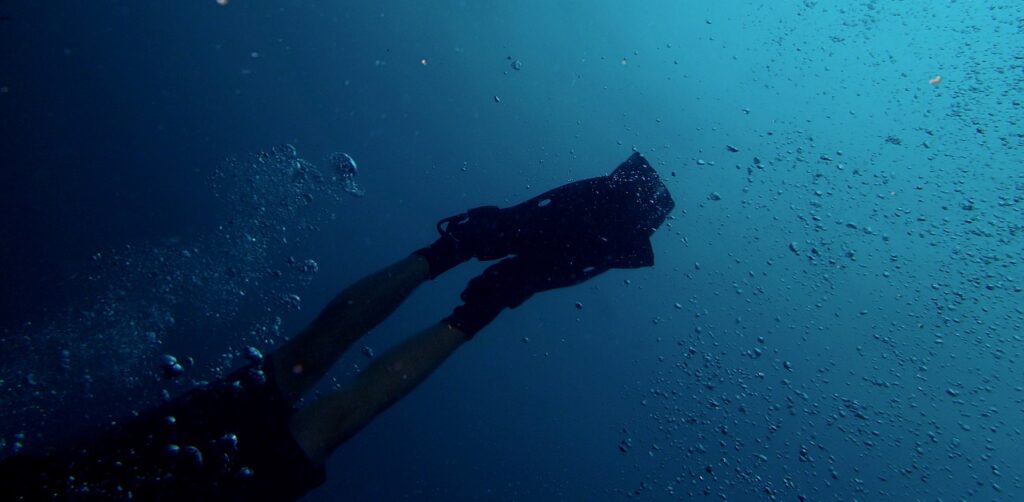

You can freedive with freediving fins, scuba fins or snorkeling fins, but you will not get an equal level of freediving performance from each.
Freediving fins are longer and give divers more power and speed underwater, enabling them to dive deeper, faster, and return to the surface more safely if needed. A mono-fin is even more efficient and powerful. Freediving without fins is possible and the demanding no-fins category in competitive freediving is sometimes considered the purest type of freediving.
If you already own scuba or snorkeling fins, you should feel free to use them, but if you’re aiming for higher performance you should choose longer freediving fins. If you wish to challenge yourself, or are not yet ready to invest in additional freediving kit, no-fins freediving is an option to try.
It is possible to freedive with scuba fins but this will reduce the speed and power with which you can move underwater, potentially reducing the depth and time of your dives. Freediving fins are longer than scuba fins. Both are longer than the short fins designed for snorkeling which may be more comfortable but will reduce freediving performance even more than scuba fins.
The True Story Book of Freediving Champion Audrey Mestre and the Story of Her Death
View on Amazon: The Last Attempt (Opens new tab)


Top rated read
If you’re already a scuba diver and thinking of trying freediving, or you have been browsing the wide range of fins available to buy online, you might be wondering whether you can freedive with scuba fins. Our article tells you more about the different types of fins, their relative sizes and their suitability for freediving.
Can you use scuba diving fins for freediving?
You can use scuba fins for freediving and they may provide more maneuverability, making you feel freer in the water. However, scuba diving fins are shorter and do not provide as much propulsion as freediving fins.
This lower propulsion capability translates into less power and speed during your dive. This means that you might not be able to dive as deeply as if using freediving fins, or might even put you in danger if you do descend deeply and find yourself having to fight harder than planned against negative buoyancy during your ascent.
Can you use short fins for freediving?
The kind of short fins which are often used by snorkelers can also be used in freediving although this will again compromise performance and limit the depth and timing of your dives. Some freedivers may still choose to try short fins because of their wearing comfort and ease of use, or because they already own a set.
Do you need fins to free dive?
You can freedive without any fins and many freedivers around the world prefer to do this all the time. No-fins freediving is even a category in competitive freediving and may be considered the purest form of the sport
In no-fins freediving, the freediver is required to descend and ascend along the diving line without using any fins or drawing themselves on the rope. This is perhaps the most physically and technically demanding freediving discipline, requiring a very high rate of work by the muscles and a long breath-hold and dive-time.
It’s ultimately up to you. You can freedive with or without fins, or you can experiment with unique fin types like monofins, if you haven’t heard of monofins, we’ve written a full article on freediving with monofins (opens new tab) which you should check out.
Why are freedive fins so long?
Freediving fins are longer than other forms of fin and designed for propelling the diver rapidly downwards and upwards, as as well as for swimming against the strong currents that may be encountered at depth.
The length of a fin is proportional to the power and propulsion it generates from the same amount of effort exerted by a diver. The ratio between the energy the diver puts into moving the fin underwater to the actual resulting propulsion is largest in freediving fins.
This higher power translation ratio also makes freediving fins a more efficient piece of kit in terms of air consumption. With a single breath, freedivers can swim deeper and return more safely with long freediving fins than with shorter scuba or snorkeling fins. If a diver experiences problems underwater, they will be able to resurface more quickly and efficiently with freediving fins.
Some freedivers prefer to dive with a single mono-fin rather than bi-fins on each foot. The mono-fin gives more power and speed again compared to any of the dual fin options, and is the preferred form of fin in competitive freediving.
When you first begin to use freediving fins or a mono-fin, the size could seem unwieldy and make your leg muscles ache. Using a slower and wider amplitude kick can make them more comfortable. Once divers are accustomed to freediving fins, they will feel less of a strain and will probably appreciate their additional propulsion power.
References
https://medicalxpress.com/news/2018-03-free-divers-defied-scienceand-dont.html
https://www.deeperblue.com/the-science-behind-the-freediving-breath-hold/
